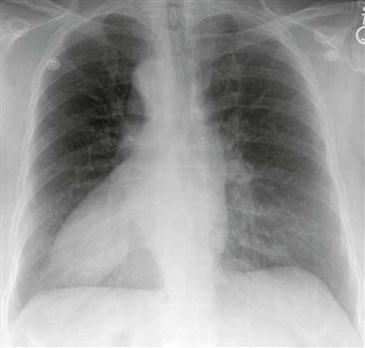CASE 52

History: No patient history is available.
1. Which findings are present? (Choose all that apply.)
A. Dextrocardia
2. What is the most likely diagnosis?
A. Situs solitus with levocardia
B. Situs solitus with dextrocardia
C. Situs inversus with levocardia
D. Situs inversus with dextrocardia
3. Which large airway disease is associated with this anomaly?
D. Allergic bronchopulmonary aspergillosis
4. What percentage of patients with situs inversus totalis have congenital heart disease?
A. 1% to 2%
B. 5% to 10%
C. 40% to 50%
D. 90% to 95%
ANSWERS
Reference
Spoon JM. Situs inversus totalis. Neonatal Netw. 2001;20(1):59–63.
Cross-Reference
Cardiac Imaging: The REQUISITES, ed 3, p 302.
Comment
Clinical Information and Associated Anomalies
Most individuals who have situs inversus totalis can live into adulthood without intervention. There is an association with Kartagener (immotile cilia) syndrome, in which patients have bronchiectasis, sinusitis, and infertility. Only 5% to 10% of these individuals have a congenital cardiac lesion. Situs ambiguus (visceral heterotaxy) or situs solitus with dextrocardia is strongly associated with complex congenital heart disease. There are two major types of situs ambiguus or heterotaxia: bilateral right-sidedness (asplenia syndrome) and bilateral left-sidedness (polysplenia syndrome). Patients with asplenia syndrome generally present early in life with cyanosis and complex congenital heart disease (e.g., transposition of the great arteries, double outlet right ventricle, common atrioventricular valve). Patients with polysplenia syndrome present later in life with less severe congenital heart defects (e.g., atrial septal defect, partial anomalous pulmonary venous connection).
Imaging
Imaging is usually straightforward; chest radiographs show that the cardiac apex is on the right and the abdominal viscera are inverted (Figure). For a complete diagnosis, CT, MRI, or cineangiography can be used to identify the left-sided inferior vena cava entering the anatomic right atrium and the left-sided liver. Dextrocardia should be differentiated from dextroversion. In dextroversion, the heart is simply shifted to the right but the cardiac apex and stomach bubble remain directed towards the left. Causes of dextroversion include the Scimitar syndrome or left-sided masses such as congenital diaphragmatic hernia.







